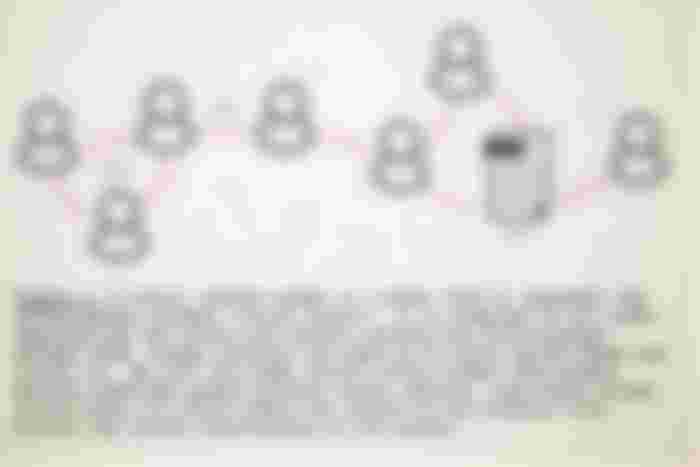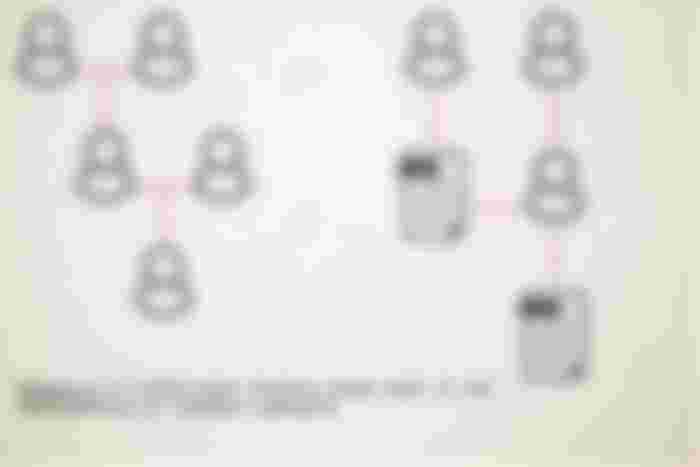Network analysis is a part of graph theory and is useful to sociologists for modeling the relationships between social actors. Networks are composed of nodes representing the actors and vectors representing the relationships between them. We’re careful not to call the nodes “people” because not all of them are human actors. Some of these nodes we can call “texts”. A text can be anything that is created by an author (a book, a video, a song, etc.). People can interact with the texts an author produces without having any direct relationship with that author, and in a sense, those texts are their own separate entity.
Figure 1 below shows an example of a social network below and includes a text.

The thing about texts is that they always used to need human actors to produce them. A human actor receives a text, interacts with it, and can either convey that information directly to another human actor or produce a new text. The human intermediary between texts is gradually becoming unnecessary. Here’s a great example: I took an excerpt from a recently published paper in Nature and fed it into a text generating neural network. Here are the original and three generated texts that come after the following input I took from that paper:
“Magnetococcus marinus (MC-1) is a magnetotactic, spherical bacterium that is capable of swimming extremely fast (Zhang et al., 2014; Fenchel and Thar, 2004; Bazylinski et al., 2013; Garcia-Pichel, 1989). MC-1 as well as the closely related strain MO-1 (Ruan et al., 2012) are equipped with two bundles of flagella on one hemisphere (bilophotrichous cells).”
How is your background knowledge in biology? Are you able to tell apart the original from nonsense?
(a) They produce two domains of their virulence factor (VF), mainly composed of SPE1 (Sporcine electrokinetic protein 1) that acts to protect MC-1 against RMI/UV (Zhang et al., 2014) and AP1 that promotes virulence.
(b) Biochemical studies of the MC-1 genome reveal a double bioluminescence signal. MC-1 displays both membrane and protein biosynthesis, each presumably involved in the efficient preparation of biochemically active substances for packaging to the flagellum.
(c) The bacterium also features a magnetosome chain, which imparts the cell with a magnetic moment (‘magnetotactic’ cell). They are assumed to swim with the cell body in front of both flagella bundles, which synchronously push the cell forward (Zhang et al., 2014).
(d) The whole flagellum contains only 3200 ATP-binding helices and a tail of 50–100 (Aiken and Loew, 2002). One ionic bond is made between the tail and the distal portion of the helix.
Chairman Zuckerberg and his elite cabal of factcheckers are trying to protect you from encountering the above problem. There’s a lot of misinformation and disinformation out there, and word on the street is that Putin’s been gaming the results of the last several seasons of America’s Got Talent. Lucky for us, Chairman Zuckerberg will ensure that all the information that reaches us is authentic and all the nodes that share it are acting in good faith. There will be a biologist on site to tell us which of the above four utterances is authentic and scientifically accurate.
My question, though, is who fact checks the factcheckers? But that’s a separate post coming later. Back to networks.
I’m working on modeling the networks of old school university researchers and people like DIY biologists who do research outside of academia. Figure 2 below gives an example of a lineage that is typical to universities. Students have advisors who instruct them to be a certain kind of scientist, those scientists grow up to be advisors, and the lineage goes on in the same way that is represented by pedigree/kinship graphs. What’s different about academic pedigrees is that they include lineages of authors and texts.

It’s only a useful fiction that we classify these things called “sciences” with clearly defined boundaries and universally standardized methodologies. Don’t get me wrong, sociology is sociology and biology is biology, but the character of, say, the sociologists produced by the University of Chicago is quite a bit different from that of the sociologists that the University of Wisconsin-Madison puts out. Each school has its own lineage of advisors who train their students to be a certain sort of scientist, who then become advisors passing on their unique composition of theory, methodology, and texts. There’s substantial overlap and if you trace their lineages back far enough, you’ll find that many of these advisors are direct descendants of some big names like Weber and Durkheim. But it’s at the level of the species (the specific academic institution) where you will find significant family resemblances to their overall approach to sociology.
The Chicago School of sociology, for example, passes on to its scientists an emphasis on the study of urban life, grounded in a strong background of symbolic interactionism and ethnographic fieldwork. Many other schools are best known for their emphasis on quantitative methodologies or critical theory and so on.
If we back up and look at all these institutions in the aggregate, we can say that they all fall into a genre of institutional science. There is another genre called citizen science. The work that I do falls into this latter domain. While I did go to university and left after getting my bachelor's, many of the people we call citizen scientists were not produced in that academic pedigree that is central to institutional science.
After my first year out of college, I had the opportunity to meet with people called DIY (do it yourself) biologists. The work they do falls outside of the university system and often takes place inside their own garages and kitchens. Public reaction to DIY biology oscillates between not taking it seriously to taking it too seriously. One day they are just hobbyists playing with toys and the next they are bad faith actors engineering the next global pandemic. There are, however, some credentialed biologists who so welcoming to this community that they’ve taken to building DIY bio labs in their garages as well and inviting aspiring citizen scientists to teach them.
In the past few years, I visited these communities of scientists the way that the old anthropologists used to visit distant tribes. I’m learning about their ways of life and modeling their networks and lineages. I do this to help me better understand citizen scientists and pedigreed scientists tend to have the distinct worldviews and practices they do.

